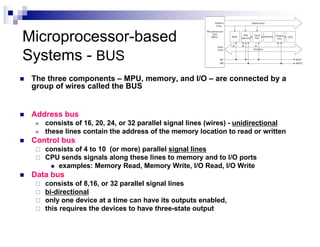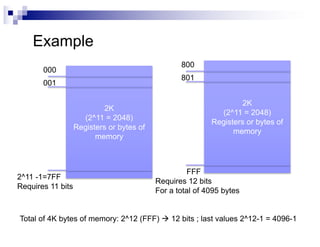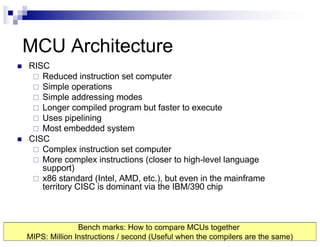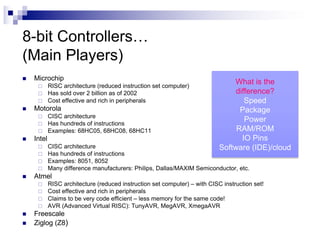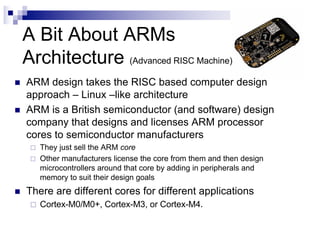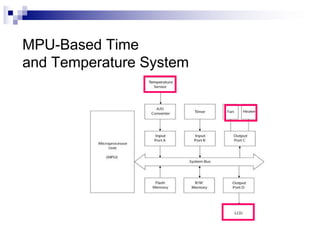Chapter_2_Embedded Systems Design_introduction_ARM.pdf
- 1. Chapter 1 Fundamentals of Microprocessor and Microcontroller Dr. Farid Farahmand Updated: Monday, February 5, 2018
- 2. Evolution n First came transistors n Integrated circuits ¨ SSI (Small-Scale Integration) to ULSI ¨ Very Large Scale Integration circuits (VLSI) n 1- Microprocessors (MPU) ¨ Microcomputers (with CPU being a microprocessor) ¨ Components: Memory, CPU, Peripherals (I/O) ¨ Example: Personal computers n 2- Microcontroller (MCU) ¨ Microcomputers (with CPU being a microprocessor) ¨ Many special function peripheral are integrated on a single circuit ¨ Types: General Purpose or Embedded System (with special functionalities)
- 3. Microcontrollers – Embedded Systems n An embedded system is a special-purpose computer system designed to perform one or a few dedicated functions often with real-time n An integrated device which consists of multiple devices ¨ Microprocessor (MPU) ¨ Memory ¨ I/O (Input/Output) ports n Often has its own dedicated software
- 6. Microprocessor-Based Systems • Central Processing Unit (CPU) • Memory • Input/Output (I/O) circuitry • Buses – Address bus – Data bus – Control bus
- 7. Arithmetic Logic Unit Register Arrays Control Unit GP- CPU CLK Reg MPU CPU Microprocessor-based System
- 8. Microprocessor-Based System with Buses: Address, Data, and Control
- 9. Microprocessor-based Systems Microprocessor n The microprocessor (MPU) is a computing and logic device that executes binary instructions in a sequence stored in memory. n Characteristics: ¨General purpose central processor unit (CPU) ¨Binary ¨Register-based ¨Clock-driven ¨Programmable
- 10. Microprocessor-based Systems Microprocessor n the “brains” of the computer ¨ its job is to fetch instructions, decode them, and then execute them ¨ 8/16/32/etc –bit (how it moves the data n contains: Arithmetic Logic Unit Register Arrays Control Unit ALU performs computing tasks – manipulates the data/ performs numerical and logical computations Registers are used for temp. storage Control unit is used for timing and other controlling functions – contains a program counter (next instruction’s address and status register) System software: A group of programs that monitors the functions of the entire system
- 11. Remember
- 12. Microprocessor-based Systems Memory n Memory is a group of registers n 16 register – address: 0-15 – in binary: 0- 1111; Address lines: A0-A3 n Serves two major purposes q storing the binary codes for the sequence of instructions specified by programs (program) q storing binary data that the computer needs to execute instructions (data)
- 13. Microprocessor-based Systems Memory Types ¨ R/W: Read/Write Memory; also called RAM n It is volatile (losses information as power is removed) n Write means the processor can store information n Read means the processor can receive information from the memory n Acts like a Blackboard! ¨ ROM: Read-Only memory; n It is typically non-volatile (permanent) – can be erasable n It is similar to a Page from your textbook
- 14. Microprocessor-based Systems Memory Classification Expensive Fast/ Cheap Slow Onetime programmable Electronically Erasable PROM Basic Technologies: Semiconductor Magnetic Optical (or combination)
- 15. Microprocessor-based Systems Memory Classification Expensive Fast/ Cheap Slow Onetime programmable Electronically Erasable PROM -4/6 transistor to save a single bit - Volatile - Fast but expensive -one transistor and one capacitor to store a bit -Leakage problem, thus requires refreshing -Used for dynamic data/program storage -Cheap and slow!
- 16. Erasable ROMs n Marked Programmed ROM ¨ Programmed by the manufacturer n Programmable ROM (PROM) ¨ Can be programmed in the field via the programmer n Erasable Programmable ROM (EPROM) ¨ Uses ultraviolet light to erase (through a quartz window) ¨ OTP refers to one-time programmable n Electrically Erasable Programmable ROM (EEPROM) ¨ Each program location can be individually erased ¨ Expensive ¨ Requires programmer n FLASH ¨ Can be programmed in-circuit (in-system) ¨ Easy to erase (no programmer) ¨ Only one section can be erased/written at a time (typically 64 bytes at a time)
- 17. Microprocessor-based Systems I/O Ports n The way the computer communicates with the outside world devices n I/O ports are connected to Peripherals ¨ Peripherals are I/O devices n Input devices n Output devices ¨ Examples n Printers and modems, n keyboard and mouse n scanner n Universal Serial Bus (USB)
- 18. Microprocessor-based Systems - BUS n The three components – MPU, memory, and I/O – are connected by a group of wires called the BUS n Address bus n consists of 16, 20, 24, or 32 parallel signal lines (wires) - unidirectional n these lines contain the address of the memory location to read or written n Control bus ¨ consists of 4 to 10 (or more) parallel signal lines ¨ CPU sends signals along these lines to memory and to I/O ports n examples: Memory Read, Memory Write, I/O Read, I/O Write n Data bus ¨ consists of 8,16, or 32 parallel signal lines ¨ bi-directional ¨ only one device at a time can have its outputs enabled, ¨ this requires the devices to have three-state output
- 19. Expanded Microprocessor-Based System 1. Note the directions of busses 2. What is the width of the address bus? 3. What is the value of the Address but to access the first register of the R/WM? You must know how to draw it! Remember: 111 1111 1111 = 7FF = 2^11-1 = 2047 2^11=2K=2048 2^11 Requires 11 bits
- 20. 2K Registers or bytes of memory 000 What? How many bits 001 2K Registers or bytes of memory 800 801 How much memory do we have? What? How many bits Example
- 21. 2K (2^11 = 2048) Registers or bytes of memory 000 2^11 -1=7FF Requires 11 bits 001 2K (2^11 = 2048) Registers or bytes of memory 800 FFF Requires 12 bits For a total of 4095 bytes 801 Total of 4K bytes of memory: 2^12 (FFF) à 12 bits ; last values 2^12-1 = 4096-1 Example
- 22. 1G bytes of memory 000 2^30 -1=3FFF FFFF Next number: 4000 0000 (in Hex) 001 Example 8 bits 30 bits!
- 23. 800 FFF Example of an 8-bit MPU RAM 2K ROM 2K A15 A0 D7 D0 8-bit
- 25. What is a Microcontroller? n A microcontroller is a small computer on a single integrated circuit containing ¨processor core, ¨memory, ¨programmable input/output peripherals n Used for specific (embedded) applications
- 26. Embedded controllers n Used to control smart machines n Examples: printers, auto braking systems n Also called microcontrollers or microcontroller units (MCU)
- 27. Embedded controllers Software Characteristics n No operating systems n Execute a single program, tailored exactly to the controller hardware n Assembly language (vs. High-level language) ¨Not transportable, machine specific ¨Programmer need to know CPU architecture ¨Speed ¨Program size ¨Uniqueness
- 28. Microcontroller Unit (MCU) Block Diagram n An integrated electronic computing and logic device that includes three major components on a single chip ¨ Microprocessor ¨ Memory ¨ I/O ports n Includes support devices ¨ Timers ¨ A/D converter ¨ Serial I/O ¨ Parallel Slave Port n All components connected by common communication lines called the system bus.
- 29. First Microcontrollers n IBM started using Intel processors in its PC ¨Intel started its 8042 and 8048 (8-bit microcontroller) – using in printers n Apple Macintosh used Motorola n 1980 Intel abandoned microcontroller business n By 1989 Microchip was a major player in designing microcontrollers ¨PIC: Peripheral Interface Controller
- 30. Different Microcontrollers (MCU) http://en.wikipedia.org/wiki/Microcontroller A more complete list is here: http://en.wikipedia.org/wiki/Category:Microcontrollers What is the difference? 8/16/24/32 bits Architecture Package Capability Memory Software (IDE)/cloud ADC (10-12 bit)
- 31. MCU Architecture n RISC ¨ Reduced instruction set computer ¨ Simple operations ¨ Simple addressing modes ¨ Longer compiled program but faster to execute ¨ Uses pipelining ¨ Most embedded system n CISC ¨ Complex instruction set computer ¨ More complex instructions (closer to high-level language support) ¨ x86 standard (Intel, AMD, etc.), but even in the mainframe territory CISC is dominant via the IBM/390 chip Bench marks: How to compare MCUs together MIPS: Million Instructions / second (Useful when the compilers are the same)
- 32. CISC vs RISC CISC Pentium/x86 are CISC-based RISC ARM-based Most mobile-phones Complex instructions require multiple cycles Reduced instructions take 1 cycle Many instructions can reference memory Only Load and Store instructions can reference memory Instructions are executed one at a time Uses pipelining to execute instructions Few general registers Many general registers RISC and CISC architectures are becoming more and more alike. *Read the LINK on the web site!*
- 33. CISC vs RISC RISC and CISC architectures are becoming more and more alike. *Read the LINK on the web site!* The Performance Equation The following equation is commonly used for expressing a computer's performance ability: The CISC approach attempts to minimize the number of instructions per program, sacrificing the number of cycles per instruction. RISC does the opposite, reducing the cycles per instruction at the cost of the number of instructions per program.
- 34. 8-bit Controllers… (Main Players) n Microchip ¨ RISC architecture (reduced instruction set computer) ¨ Has sold over 2 billion as of 2002 ¨ Cost effective and rich in peripherals n Motorola ¨ CISC architecture ¨ Has hundreds of instructions ¨ Examples: 68HC05, 68HC08, 68HC11 n Intel ¨ CISC architecture ¨ Has hundreds of instructions ¨ Examples: 8051, 8052 ¨ Many difference manufacturers: Philips, Dallas/MAXIM Semiconductor, etc. n Atmel ¨ RISC architecture (reduced instruction set computer) – with CISC instruction set! ¨ Cost effective and rich in peripherals ¨ Claims to be very code efficient – less memory for the same code! ¨ AVR (Advanced Virtual RISC): TunyAVR, MegAVR, XmegaAVR n Freescale n Ziglog (Z8) What is the difference? Speed Package Power RAM/ROM IO Pins Software (IDE)/cloud
- 35. A Bit About ARMs Architecture (Advanced RISC Machine) n ARM design takes the RISC based computer design approach – Linux –like architecture n ARM is a British semiconductor (and software) design company that designs and licenses ARM processor cores to semiconductor manufacturers ¨ They just sell the ARM core ¨ Other manufacturers license the core from them and then design microcontrollers around that core by adding in peripherals and memory to suit their design goals n There are different cores for different applications ¨ Cortex-M0/M0+, Cortex-M3, or Cortex-M4.
- 36. ARM Processor IP
- 37. Applications of ARM-Based Microcontrollers http://en.wikipedia.org/wiki/List_of_applications_of_ARM_cores Who is using ARM? Check this out! Most Cellphones!
- 38. Design Examples ….. Microcontrollers vs. Microprocessors
- 39. MPU-Based Time and Temperature System
- 40. MCU-Based Time and Temperature System
- 41. References n Computer History Museum: http://www.computerhistory.org/ n Read about microcontrollers: http://www.mikroe.com/en/books/picbook/2_01chapter.htm n Lots of good information exist on Wikipedia about microcontrollers http://en.wikipedia.org/wiki/ n History of transistors: http://inventors.about.com/library/weekly/aa061698.htm n Nice transistor timeline by Intel: http://www.intel.com/technology/timeline.pdf n I used a few slides from here: http://www.ceng.metu.edu.tr/courses/ceng336/_documents/introduct ion.pdf n ARM related references: ¨ http://mc2.unl.edu/2013/10/03/getting-started-with-arm-microcontrollers/ ¨ http://www4.cs.fau.de/Lehre/SS06/HS_AKES/slides/ARM.pdf - Very good reference !
- 42. References - RISC n http://cse.stanford.edu/class/sophomore- college/projects-00/risc/ n http://en.wikipedia.org/wiki/Complex_instruction_set_co mputer n http://en.wikipedia.org/wiki/RISC n http://arstechnica.com/articles/paedia/cpu/pipelining- 1.ars/4

















